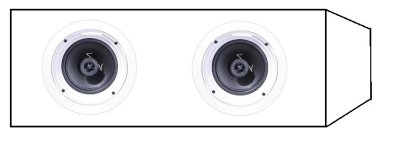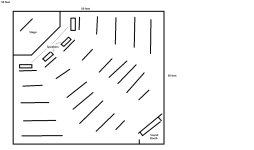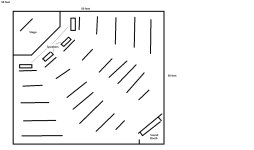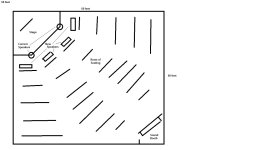So I've got an interesting project plan to bounce off the wizards in this group! When looking at improving our church's sound situation, I'm planning to replace our 2 traditional PA speakers with some low profile sound bar style speakers that I can tuck right up against the ceiling because I need the headroom for visibility of the projector screen up front.
Here's my plan: Using the Klipsch R-1650-C 6.5" ceiling speakers, build 4 boxes with 2 speakers in each box (Or 3 or 4 speakers per box if need for volume), and spread them out across the front ceiling... pointing down at the correct angle to cover the whole auditorium. (I can get the speakers for $50 each right now)
We have 2 powered subwoofers on the floor that easily carry the lows, so these are only supposed to run the mids and highs. I'm trying to do this on a low budget... I realize to make this 100% professional audio, there's a million things to consider, but I hope to just kinda cover the basics since we're not talking about super pro audio here... just some pretty good sound.
1. Is this a ridiculous idea or might actually work?
2. My research seems to indicate that a sealed box would be best for this application since I'm not looking for them to push any freq below 100hz. Agreed?
3. What volume/size box should I be shooting for?
Anything else?
Thanks!
Here's my plan: Using the Klipsch R-1650-C 6.5" ceiling speakers, build 4 boxes with 2 speakers in each box (Or 3 or 4 speakers per box if need for volume), and spread them out across the front ceiling... pointing down at the correct angle to cover the whole auditorium. (I can get the speakers for $50 each right now)
We have 2 powered subwoofers on the floor that easily carry the lows, so these are only supposed to run the mids and highs. I'm trying to do this on a low budget... I realize to make this 100% professional audio, there's a million things to consider, but I hope to just kinda cover the basics since we're not talking about super pro audio here... just some pretty good sound.
1. Is this a ridiculous idea or might actually work?
2. My research seems to indicate that a sealed box would be best for this application since I'm not looking for them to push any freq below 100hz. Agreed?
3. What volume/size box should I be shooting for?
Anything else?
Thanks!
Attachments
I think I found my answer to #3... The Klipsch ME-650-C enclosure is 5" x 16.8" x 13.3" so 1117.2 cubic inches... I guess I could go with that? It says "The optimized enclosure volume provides consistent acoustic performance..."
One thing to consider when compromising like this, is even coverage over the larger area. That can entail various factors but in a church environment I think you want to avoid treble hotspots. A more relaxed tone may be preferred rather than the other way around.
The physically displaced coaxial drivers you show can vary with lobing and directivity, and have a tweeter diffraction element to consider. Try walking under one to see.
I don't know whether you've considered full range drivers. They too have considerations, but in such a compromise as yours they can give acceptable results when located back from the audience. I only mention them to open your eyes to the possibility of other options.
The physically displaced coaxial drivers you show can vary with lobing and directivity, and have a tweeter diffraction element to consider. Try walking under one to see.
I don't know whether you've considered full range drivers. They too have considerations, but in such a compromise as yours they can give acceptable results when located back from the audience. I only mention them to open your eyes to the possibility of other options.
It's not a box, just a ceiling adapter, i.e. driver is high Qt for IB, so as big a stuffed ~aperiodic box as practical +EQ and will need to array them in an arc whether mono or stereo.
In that case I'd be sure to have EQ available. Treble is unnatural when it stands out.
I'd also experiment with them. Simply you could walk around them and assess their performance vs coverage, then consider the distance to the seats these angles cover. Ideally that would involve measurements instead.
GM has a good point about arraying. Using two side by side with a gap has a cancellation effect which can be a problem when you don't want it to be.
I'd also experiment with them. Simply you could walk around them and assess their performance vs coverage, then consider the distance to the seats these angles cover. Ideally that would involve measurements instead.
GM has a good point about arraying. Using two side by side with a gap has a cancellation effect which can be a problem when you don't want it to be.
I'll be arraying all 4 boxes in an arc around the stage, or do you mean that this effect would be a problem if I'm putting 2 speakers in a box? Should I rather angle each speaker in the box a little bit different to direct the tweeters to different areas? See attached pic.GM has a good point about arraying. Using two side by side with a gap has a cancellation effect which can be a problem when you don't want it to be.
EDIT: The effect you're talking about - I searched it a bit and do you mean comb filtering? as described here:
Attachments
Last edited:
My main thoughts/questions are:2 traditional PA speakers
What size are the current/old speakers? Woofers, tweeters, quantities of each, and are the tweeters horn loaded?
How much output are you expecting from the new ones? Is there comparable volume displacement between old and proposed new? Are sensitivities similar between old and new?
Are the old speakers line sources or placed anywhere special where you get more even sound pressure levels from the front pews to the back ones? (I assume that's what the lines are) In your drawing, it seems that some people are going to be very close the speakers and others rather far. Maybe you already have something similar going on and it's OK, but just looking at the drawing it made me curious.
I'm pretty sure that what we have right now is a pair of 10yr old Mackie C200... with the single round tweeter. They're positioned closer to the stage so that the spread can cover most of the seats. (That's what the rows are: seating... I updated the drawing)What size are the current/old speakers?
The current speakers have about 10db falloff from front to back of the room, AND since they're so close to the stage, there's a lot of bleed out the back of the plastic cabinet and I think it might be affecting our gain before feedback on mics at the front of the stage, and especially on the floor in front of the stage.
Since we have 12ft ceilings, I'm hoping that bringing the speakers further into the room will help with both problems.
I haven't done proper calculations for volume output. Not sure if this is right... I think it would be
Currently: 2 C200: 2@200=400W/(1000Peak)
Planned: 2x4=8 R-1650-C: 8@35=280W/(1120Peak)
So it looks like maybe a bit quieter?, but our board and amp are not maxed now, so I don't think we're using all 400W currently anyway.
Attachments
is 96 dB sensitivity on the woofer, and an 8 ohm load. 10 inch woofer, likely around 350 square cm for Sd.Mackie C200
91 dB sensitivity, 8 ohm load. 6.5 inch woofer Sd probably around 130 square cm.Klipsch R-1650-C 6.5"
No idea on Xmax on either, but probably less relevant since you are using a subwoofer.
Are you going to add amp channels or just use the two channels already used on the Mackies and then do a series/parallel configuration on the Klipschs?
The tweeter on the Mackies is a compression driver with high output capability and restricted dispersion. That's why you can get away with just using 2 of those to cover the room. A normal dome tweeter is probably going to struggle under similar conditions unless you aren't going to play very loudly.might I be better to snip the one tweeter so I only have one
I was hoping to use the same amp and just series/parallel them.Are you going to add amp channels or just use the two channels already used on the Mackies and then do a series/parallel configuration on the Klipschs?
I don't understand how the sensitivity affects it yet, but to me it looks like things are somewhat close? (I'm doing a deep dive, crash course into speaker designing, with only limited prior knowledge that comes from being an amateur soundman)
I guess I'll just have to squeeze them as close together as possible and hope that the comb filtering off the tweeters isn't too bad.
Do you think I'd benefit from tilting one speaker slightly more down than the other in the same box? (I have a pic posted previously showing that)
It would be a more complex build, but I guess it would give better coverage over the depth/length of the seating area... Also the axis of comb filtering would change - not sure if that really matters🤔
My gut feel for the situation is to keep things simple and use as many drivers as you can, since you're going from PA speakers to home audio speakers. PA systems are designed to play louder inherently, so you need to overcome some of that. How many drivers you use and how they're wired will determine the ultimate voltage sensitivity of the system. A -3 dB difference in sensitivity means you have to use twice the power to achieve the same output as the reference system.
I wouldn't bother with trying to aim speakers differently up and down if you use a horizontal line. I'd aim them toward the farthest listener and see how that goes.
I'd keep all the tweeters on and ignore comb filtering initially. This will likely measure worse than it sounds.
If you go with 4 drivers per cabinet, you can basically have 4 short line arrays (one for each seating area). The more typical orientation is vertical for a line array, but horizontal would probably still give some benefits (primarily narrowing dispersion in the upper speech region).
I'm one that likes to prototype quick and cheap. You could build one short array like this, install it temporarily, and see how it performs. If my ideas are wrong, it'll show up pretty fast in just walking around while playing music or speech. You could also back down to 2 or 3 drivers just with rewiring and compare the pattern/coverage. You could also test a more typical vertical orientation for the short line and see how that does.
Of course there's software to analyze all these kinds of things, but that's typically something people doing this for a living use. I'm not one of those people, so take my advice as more general and not 100% informed by direct experience with this particular application.
Some more typical line array ideas here:
https://www.prosoundtraining.com/2023/08/04/line-array-realities/
I wouldn't bother with trying to aim speakers differently up and down if you use a horizontal line. I'd aim them toward the farthest listener and see how that goes.
I'd keep all the tweeters on and ignore comb filtering initially. This will likely measure worse than it sounds.
If you go with 4 drivers per cabinet, you can basically have 4 short line arrays (one for each seating area). The more typical orientation is vertical for a line array, but horizontal would probably still give some benefits (primarily narrowing dispersion in the upper speech region).
I'm one that likes to prototype quick and cheap. You could build one short array like this, install it temporarily, and see how it performs. If my ideas are wrong, it'll show up pretty fast in just walking around while playing music or speech. You could also back down to 2 or 3 drivers just with rewiring and compare the pattern/coverage. You could also test a more typical vertical orientation for the short line and see how that does.
Of course there's software to analyze all these kinds of things, but that's typically something people doing this for a living use. I'm not one of those people, so take my advice as more general and not 100% informed by direct experience with this particular application.
Some more typical line array ideas here:
https://www.prosoundtraining.com/2023/08/04/line-array-realities/
Ok Cool. Thanks.A -3 dB difference in sensitivity means you have to use twice the power to achieve the same output as the reference system.
Yeah, I'm buying enough speakers that I can make 4 boxes of 4, but was hoping to only need 2 or 3 per box. I'm of the same mindset - to prototype and see by listening, but really appreciate the advance input of more knowledgeable/experienced people to keep me out of any likely or obvious pitfalls. So Thanks!
I'm even thinking, I might be able to just put the existing loudspeakers in the outside corners and then fill with homemade "sound bars" but power balancing might be a problem with that plan, so actually... probably not.
I can't do a vertical array since the purpose of this project is to tuck the speakers up close to the ceiling where they would be in the line of sight for people at the back looking at the projector screen at the front.
Yeah right on. Hopefully it sounds OK in real life. Shouldn't actually be too bad I think. Comb filtering should only be a bit in the very high freq.I'd keep all the tweeters on and ignore comb filtering initially. This will likely measure worse than it sounds.
Hi
I am thinking this will not work very well. The Klipsch R-1650 have a sensitivity of 88db at 1 metre, with a maximum power of 35 watts. This means a maximum output of 103db per speaker. The Mackie C200's have a maximum output of 118db. To get to 118db you have to double your Klipsch speakers 5 times! That makes 32 Klipsch speakers to get the same volume output as 1 Mackie! The PA speakers are designed to play loud for longer than hifi speakers as they are designed to dissipate heat better. The Horn treble unit on the Mackie is directional compared to the Klipsch. There could be more chance of feedback with the dome tweeters on the Klipsch.
I am thinking this will not work very well. The Klipsch R-1650 have a sensitivity of 88db at 1 metre, with a maximum power of 35 watts. This means a maximum output of 103db per speaker. The Mackie C200's have a maximum output of 118db. To get to 118db you have to double your Klipsch speakers 5 times! That makes 32 Klipsch speakers to get the same volume output as 1 Mackie! The PA speakers are designed to play loud for longer than hifi speakers as they are designed to dissipate heat better. The Horn treble unit on the Mackie is directional compared to the Klipsch. There could be more chance of feedback with the dome tweeters on the Klipsch.
Bummer, well the speakers are already on their way, so I guess I'll put something together and try it out and see what happens. I hope in real life it works better than the numbers. 😬thinking this will not work very well.
I appreciate the input though. There's a lot about the "numbers" that I'm not really up to speed on. Maybe I'll get lucky and I haven't been driving the mackies to the upper range of their ability?
I would be bringing them further forward compared to the PA speakers, so I'm hoping they will reduce the chance of feedback on stage or even in front of the stage.
I guess if all else fails, I'll have to put ceiling speakers in my house 🤪😆.
Assuming that math is right (uncorrelated sources), you're still only talking about a 3 dB difference going from 16 speakers to 32 speakers. Or 6 dB going from 16 to 64 speakers. 3 dB is pretty much in the "yeah that's a bit louder" range.That makes 32 Klipsch speakers
The more standard way to calculate this is assuming correlated sources, which gives 6 dB increase per doubling of drivers (assuming equal power per driver in all cases), not 3 dB. In this scenario it's likely to be a mix depending on frequency, but I doubt it's going to be closer to 3 dB per doubling overall.
Uncorrelated sources calculator
http://www.sengpielaudio.com/calculator-spl.htm
4 uncorrelated sources = +6 dB compared to 1 source
8 uncorrelated sources = +9 dB
"Incoherent or noncoherent means the signals of the overdubbed channels are irrelative like a violin and a trumpet, that means having no correlative relationship. Sometimes we say uncorrelated when we mean incoherent. Given two incoherent sources their combined effect is the sum of their acoustic power."
Correlated sources
http://www.sengpielaudio.com/calculator-coherentsources.htm
4 correlated sources = +12 dB
8 correlated sources = +18 dB
"If a source creates a level L1 and a second source L2 that is built from the first, (as two closely powered loudspeakers get the same signal), then this gives a sum of the level which is 6 dB higher than the level of one signal."
Last edited:
6db increase is possible with line arrays. With 4 speakers per box, the line array will be very short and will not give 6db increase per doubling at a distance to the audience.correlated sources,
Maybe David does not need to match the volume of the existing Mackie speakers?
If he has already has the speakers coming, then it is worth trying to see how it sounds.
If the result is to get legibility of voice to the back of the room, then maybe the Klipsch speakers could be installed as ceiling speakers more at the back of the room.
- Home
- Loudspeakers
- Multi-Way
- DIY Soundbar as Church mains




